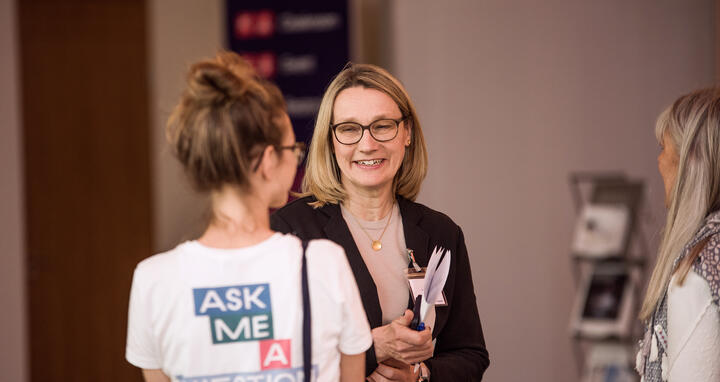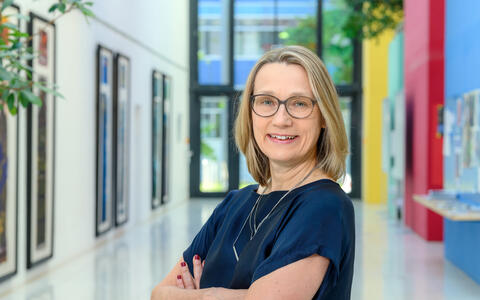“Networking is the model of the future”
gesundhyte.de: Prof. Sander, what drew you back to Germany from San Diego?
Maike Sander: What I find very appealing is the potential we possess to collaborate with partners and shape something truly impactful. I view this as a tremendous opportunity for research in Germany and more widely throughout in Europe. Coming from a U.S. perspective, what has struck me in recent years is how interconnected research is here. People strive to work through networks, to address major scientific challenges through joint structures. This is exactly the model we need for the future! Today, it is impossible for a single professor or a single laboratory to bring in or acquire all the expertise necessary to make real progress in biomedicine. In a collaboration, each partner can bring in their unique expertise from across many different disciplines.
In the USA, this way of working is sometimes more difficult, because funding is primarily oriented toward individual research groups, often for limited periods of time. Institutions in the U.S. are not funded by the government per se. Individual professors generally finance their laboratories through third-party funding. Contrast that with the situation here, where research centers such as the Max Delbrück Center can join forces with other institutes, from within the Helmholtz Association and beyond, to tackle the really big questions in health research. I also see great opportunities particularly in the Berlin scientific ecosystem, where we have been making innovative advances in this direction. Look, for instance, at the collaborations between Charité ̶ Universitätsmedizin Berlin, the Berlin Institute of Health at Charité (BIH) and the Max Delbrück Center. With these partners, we have a real chance to shape the medicine of the future. It is the combination of all these factors that made Berlin so appealing for me.
gesundhyte.de: How efficient is the German research community when you compare it with the major centers in the USA?
Maike Sander: In Boston, in the Bay Area, or in San Diego, you find very dynamic markets that give the U.S. a clear advantage in many respects. This creates a lively mixture of private investors, venture capital and often huge private donations that drive certain research fields and generate fresh ideas. It constantly creates new models that promote innovation. Here in Germany things are a bit slower; the capital needed to finance start-ups in a new field does not flow quickly or without considerable bureaucracy. On the other hand, in Germany there is more stability and continuity, and that, too, is very important for innovative research.
gesundhyte.de: What would be necessary to accelerate the momentum?
Maike Sander: One idea would be to conceptualize ways to mix public and private funding. There need to be clear incentives to promote commercialization so that results are translated into useful diagnostics and therapies quickly. We have very solid governmental funding in Germany, excellent scientists, and great ideas. But in order for us to bring these innovations into practice, this module is still missing: Start-ups need dynamic options for private funding, as well as a large capital market.
gesundhyte.de: How can this be achieved?
Maike Sander: Again, it's all about networks. In San Diego, we had events several times a year where investors came and scouted for opportunities. Such platforms are an ideal environment for an ongoing exchange of ideas; professors and investors in the U.S. enjoy very close ties. And when ideas emerge, the path to realization is very short. So, the big question is: how can we promote such a culture and attract investors over here? How can we show them that our ideas and discoveries will eventually be very profitable? I see that as a task for us as a network: Together, we can show what Berlin has to offer and promote interest in the location. This will create more meetings and networks, especially including investors.
The potential of talent
gesundhyte.de: How do you see the Max Delbrück Center and the life sciences developing in the capital region?
Maike Sander: The enormous potential of Berlin starts with the fact that we have three major universities that are already cooperating as the Berlin University Alliance. Add to that all the non-university research institutions; which have an enormous appeal. These have also joined forces as the “Berlin Research 50.” This represents a significant strength of the city: a level of density of scientific activity that is not often encountered. Many of the crucial building blocks we need for good science are already on hand. That goes beyond great research; Berlin has tens of thousands of students, an incredible potential source of talent! Beyond that, ideas, diversity, creativity and innovation have to be lived, which is another advantage of Berlin, because it is so attractive as a metropolis. This means we can attract talent and professionals from all over the world. Within our triangle formed by Charité, BIH and the Max Delbrück Center, I see our role as a driver of innovation. We are on the forefront of new technologies, and we are furthering their development by applying them to the most complex questions related to human diseases. These advances are happening in close cooperation with clinicians. Now we need to consider what strengths and focal points already exist, and how we can expand them and further establish ourselves as global leaders.
gesundhyte.de: What specifically do you have in mind?
Maike Sander: “From bench to bedside and back” is a principle we are already living at the Biotech Campus in Berlin-Buch, where the main Max Delbrück Center campus is located. I am talking about the Experimental and Clinical Research Center (ECRC), which we founded together with the Charité in 2007. Another project that follows this principle is our new idea of creating the Berlin Cell Hospital. We want to bring new technologies such as single-cell analysis or CRISPR methods into the clinic. These technologies allow us to obtain a extremely detailed view of disease processes, at a much higher resolution than ever before. This is a precondition to take prevention to the molecular level, to diagnose and treat diseases much earlier, even before patients exhibit overt symptoms and before the body has suffered irreparable damage. This is only possible through close collaborations between clinicians and researchers who are able to collect and interpret large datasets.
gesundhyte.de: Are there other examples?
Maike Sander: One fantastic area of progress has been the development of model systems we call organoids. These are mini-organs which we produce in the lab, grown from patients’ own stem cells. They serve as new models to study human disease processes. Organoids are becoming increasingly important for research and industry, but to fulfill their potential in practice, we have to learn to automate their production and scale up the process. The aim is to use high-throughput screening methods to determine the point at which disease deviates from health, and whether some active substance can step in right at that point and intercept the pathological process. To achieve this, we will need thousands of high-quality organoids at a time. That would represent an enormous step forward, but it will require that many disciplines must come together, particularly bioengineering and data science. I see an opportunity here that goes well beyond our ambitions at the Max Delbrück Center. The way forward is to expand and develop these opportunities across Berlin, through even closer collaborations.
The interview was conducted by Jutta Kramm and Jana Schlütter.
- Prof. Maike Sander
-
Biography
-
Prof. Maike Sander is an internationally active stem cell and diabetes researcher. Since November 2022 she is heading the Max Delbrück Center for Molecular Medicine in the Helmholtz Association (Max Delbrück Center) in Berlin as Scientific Director.
Maike Sander
© Peter Himsel/Max Delbrück CenterSander studied medicine at the University of Heidelberg and then spent more than 25 years conducting research in California. Most recently she served as director of the Pediatric Diabetes Research Center at the University of California in San Diego.
Sander became known for her groundbreaking diabetes research, particularly on insulin-producing beta cells, whose development and function she analyzes with her team. The researchers produce pancreatic islets from human pluripotent stem cells. These organoids mimic the natural microenvironment of beta cells in the Petri dish and allow detailed analyses. Regenerating beta cells or replacing them using human pluripotent stem cells could become a therapeutic approach for both forms of diabetes. “It is not yet clear how to transplant beta cells derived from stem cells into people and protect them from rejection in the body,” Sander emphasizes. “To find answers to these questions, science and industry must collaborate intensively.”
She is a recipient of the Juvenile Diabetes Research Foundation's Grodsky Award and the Alexander von Humboldt Foundation's Research Award. In 2022, she received the Albert Renold Award from the European Society for the Study of Diabetes (EASD).





